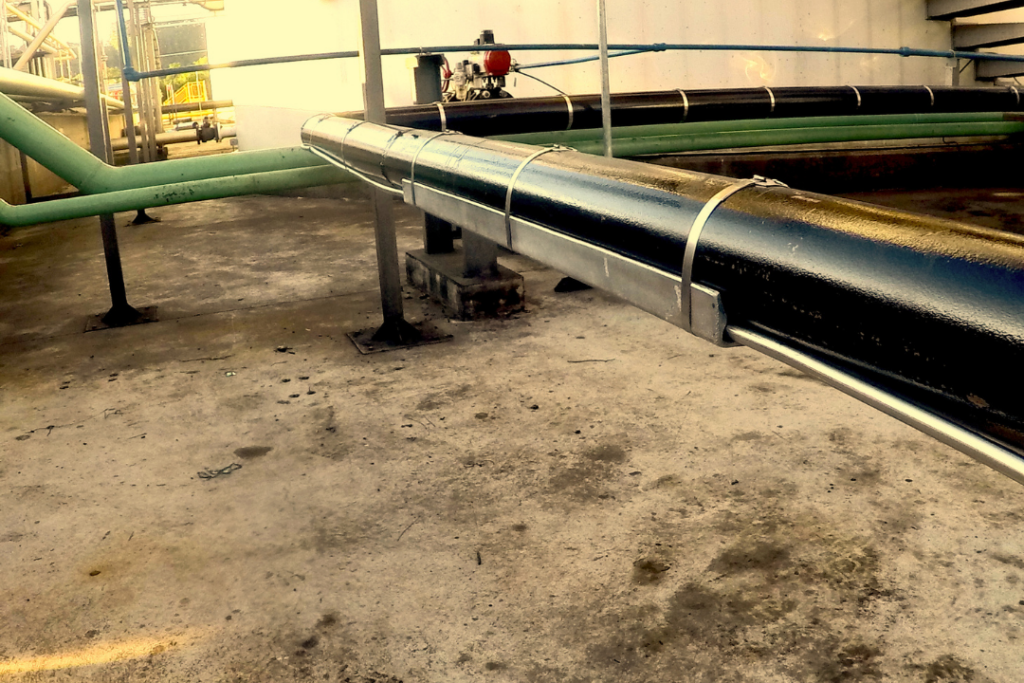“Discover how the Steam Tracing system travels through the pipeline, transfers heat to industrial processes and returns to the boiler, optimizing energy efficiency. This article details the vapor-condensate cycle, highlighting how condensate return reduces energy waste and maximizes the sustainability of industrial systems, especially with Tayga's advanced solutions.”
Steam Tracing is a solution widely used in industrial processes to maintain the ideal temperature of pipes and equipment.. Whether to prevent fluids from freezing in cold environments or to ensure substances remain in a fluid state, Steam Tracing is essential for the operational efficiency of several industries. However, efficiency does not just depend on heat release, but also how the steam travels through the system and returns to the boiler. This ensures energy recovery and minimizes waste.
How the Steam Dash System Works
Steam Tracing involves the passage of hot steam through pipes parallel to or in contact with the main process lines. The objective is to ensure that heat is transferred efficiently to the process medium, whether fluid or gaseous. Throughout the system, steam passes through several stages, and it is important to ensure that, after releasing your heat, it is returned efficiently to the boiler.
The Path of Steam in the Pipe
When steam is released from the boiler, it follows the steam trace pipes, transferring heat to process fluids. This vapor circulates through the piping in direct or indirect contact with the main line, maintaining the temperature required for operation. During this heat transfer, the steam condenses, releasing thermal energy to heat fluids in the industrial process.
Return of Condensate to the Boiler
After heat transfer, steam turns into condensate (water). The efficiency of the Steam Trace system depends on the ability to return this condensate to the boiler, where it will be heated again and turned back into steam. Condensate return is one of the main factors that minimize energy waste. This condensate is collected and conveyed through return lines, avoiding the need for disposal and ensuring that it is reused in the production cycle.
Advantages of Condensate Return
- Reducing Energy Waste: Condensate return significantly reduces energy consumption. As the returned water is already heated, the boiler uses less energy to turn it back into steam.
- Water Saving: Instead of pouring out the condensed water, it is reused in the system. This not only reduces water consumption, but also avoids the costs associated with fresh water treatment.
- Increased Operational Efficiency: Condensate recirculation also improves boiler efficiency, as it reduces the amount of steam needed to reach the desired temperatures. This means the plant can operate more efficiently and with less wasted resources..
Loss Prevention in the Steam Tracing System
To avoid waste in the Steam Trace system, It is essential to use high quality equipment and carry out regular maintenance. Some critical points to avoid losses include:
- Steam Trap Maintenance: Steam traps are responsible for releasing condensate from pipes, allowing return to the boiler. Regular maintenance ensures the trap works properly and prevents water build-up in the steam lines.
- Adequate Thermal Insulation: Pipe insulation is crucial to prevent heat loss. Steam Trace Systems with high quality thermal insulation minimize heat dissipation during the steam journey and condensate return.
- Pressure and Temperature Monitoring: Adequate pressure and temperature control within the system is essential to ensure that the steam meets the demands of the process and that the condensate is efficiently returned to the boiler.
Tayga's Role in the Efficiency of Steam Dash Systems
Tayga offers Steam Tracing solutions designed to maximize energy efficiency and minimize waste. Our systems include advanced technology to ensure that steam travels through the piping efficiently and that condensate returns properly to the boiler. Besides that, We offer high quality thermal insulation, monitoring systems, and state-of-the-art steam traps, ensuring your system operates with maximum efficiency and reliability.
Conclusion
The efficiency of a Steam Tracing system depends not only on the ability to maintain the ideal temperature in industrial processes, but also the efficiency with which the condensate is returned to the boiler. The steam-condensate cycle not only improves energy efficiency, but also reduces operating costs and environmental impact. With efficient and well-designed Steam Tracing solutions, like those provided by Tayga, Industries can ensure that their processes operate sustainably and effectively.
If you are interested in implementing or optimizing your Steam Tracing system, Contact Tayga for customized solutions that meet your needs.

DDiscover how Tayga heating solutions can transform your industrial operations.
Get in touch today to learn more about our services and how we can help you achieve excellence on your next project.

We are available through do site (click here) or by e-mail contato@taygahs.com or at phone and Whatsapp (21) 9.8819-3687.
We also recommend reading our materials on the heating and insulation systems implemented by Tayga (just click and you will be redirected):


